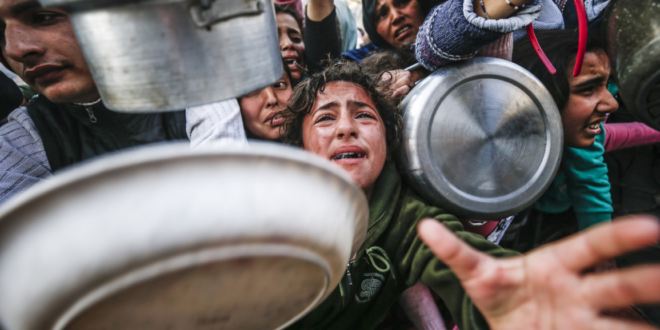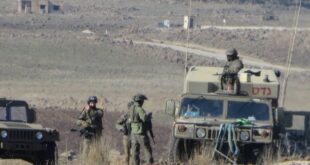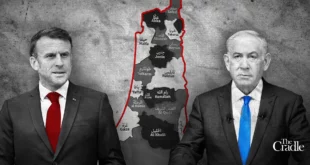The new aid plan bypasses the UN and uses private charities and security firms to deliver aid in Gaza, with fears it is a fig leaf to advance mass displacement
The US is establishing a new system relying on private firms to coordinate humanitarian aid deliveries to the Gaza Strip, as Israel’s total blockade continues for a third month and famine looms across the territory.
The aid mechanism, which will be managed by a newly created private charity, the Gaza Humanitarian Foundation (GHF), is aimed at delivering food and basic necessities as part of a broader US-Israeli effort to take control of aid distribution.
Satellite images reportedly show that a series of sites are being prepared by Israel as distribution centres, according to media reports.
Under the new plan, announced by US ambassador to Israel Mike Huckabee last Friday, the foundation will set up four distribution sites to provide food, water, hygiene kits, and medical supplies to 1.2 million people initially, which is around 60% of Gaza’s population.
Private American security contractors will be used to secure the delivery hubs, and Gazans would be forced to move south to receive aid in an area cordoned off by Israel’s military.
Details of who would fund and run the programme, as well as how it would work on the ground, are not given, nor does the proposal provide a timeframe. Essential aid supplies are depleting quickly in Gaza under the unrelenting Israeli siege.
“The entire plan is a non-starter,” Ahmed Bayram, Middle East and North Africa regional media advisor for the Norwegian Refugee Council (NRC), told The New Arab. “It sets a dangerous precedent, giving an occupier the power to engineer the aid system on its own terms and raising serious questions about the future of how we deliver aid.”
Humanitarian groups have squarely opposed the new aid system, which would replace the current one run by the United Nations and other international aid agencies. The UN slammed the scheme for sidestepping the existing distribution network, and for drastically reducing humanitarian access points from the 400 that operated across Gaza before Israel’s total blockade to just four.
“Israeli authorities already control the entry of aid into Gaza. Adding another layer of control only worsens delays, reduces vital supplies, and deepens the suffering of a population already trapped under siege,” Khalid Elsheikh, executive director of Doctors Without Borders (MSF) UAE, told TNA. He reiterated that a relief system must ensure free and equitable access to humanitarian supplies throughout the territory.
Aid experts warn this would strain the humanitarian system, making it nearly impossible to ensure equitable access to essential supplies for hundreds of thousands of people. They further noted that Palestinians have regularly come under attack from Israeli forces while collecting aid.
“A population being starved, forcibly displaced and bombed all at once and being told to line up for food in fenced-off zones run by private military contractors?” Bushra Khalidi, Palestinian Territory policy lead at Oxfam, questioned during a presser on Wednesday.
With a handful of aid sites under the Trump administration’s proposed plan, displaced Palestinians could be forced to walk long distances carrying heavy food rations for their families.
“Using humanitarian aid as a tool to incentivise people to move from one place to another is completely unacceptable,” Jonathan Crickx, UNICEF’s chief of communications for Palestine, said in an interview with The New Arab, stressing that aid workers distribute relief to people in need “wherever they are”.
He emphasised that at least 1.9 million Palestinians so far have been displaced across the coastal strip as a result of Israeli bombardments, fighting, and conditions tied to security and food distribution.
“This mechanism appears practically unfeasible, incompatible with humanitarian principles and will create serious insecurity risks, all while failing to meet Israel’s obligations under international law,” the UN Office for the Coordination of Humanitarian Affairs wrote last week in a document obtained by CNN.
UN agencies have urged Israel to end its over 10-week siege on Gaza and to allow unrestricted humanitarian access, calls that Tel Aviv has so far rejected.
Critics say the US initiative would also advance Israel’s plans to coerce besieged Palestinians to move from north to south Gaza near the Egyptian border, and eventually out of the Strip, viewing it as complicity in forced displacement. The UN reports that 90% of the population has been displaced during the war, often multiple times.
The controversial proposal effectively calls for transferring control of Gaza’s aid distribution to a supply scheme largely based on plans discussed by Israel in recent weeks that would bypass international aid agencies and weaken the framework of international humanitarian law.
“How is it possible to provide the needed quantities for 2.1 million people?” Crickx asked. The humanitarian observed that the Israeli aid blueprint allows for only 60 trucks per day to enter Gaza, far fewer than the 650 trucks entering daily during the ceasefire, which he said was already “barely sufficient” to meet basic needs.
Since early March, the Israeli blockade has cut off all relief to the Gaza Strip, pushing its inhabitants toward starvation amid basic supplies rapidly running out, collapsing supply chains, a near-total power blackout, severe water shortages, and a devastated healthcare system. The Palestinian Authority formally declared Gaza a famine zone last week.
Returning from his last field trip to Gaza a couple of days ago, UNICEF’s State of Palestine communications lead described the situation as “absolutely catastrophic” and was adamant that the enclave’s 1.1 million children risk dying from malnutrition if the full siege persists.
“The Israeli occupation forces are targeting every aspect of the health system across Gaza and any survival capacity for our people’s bodies,” Dr Mohammed Salha, Director of Al Awda hospital in North Gaza, said in a statement shared with NGOs.
The main relief organisations working in the Palestinian territory have refused to cooperate with the Israeli plan, enforcing a military-controlled delivery system which, they said, would weaponise aid and could worsen civilian suffering.
Although Israel has repeatedly accused Hamas of diverting and profiting from relief deliveries to Gaza, aid groups maintain that the vast majority of food aid reaches civilians in need and, instead, consider Israel’s complete ban on humanitarian assistance the primary cause of the hunger crisis in the enclave.
Aid officials explicitly said they could not participate in the US-Israeli scheme, fearing it violates “fundamental humanitarian principles” and breaches international law.
“It forces further displacement. It exposes thousands of people to harm,” UN humanitarian chief Tom Fletcher told the Security Council. “It restricts aid to only one part of Gaza while leaving other dire needs unmet. It makes aid conditional on political and military aims. It makes starvation a bargaining chip.”
“The UN cannot join any effort that does not meet our principles for the distribution of humanitarian aid, including humanity, impartiality, independence and neutrality,” UN deputy spokesperson Farhan Haq said.
Russia, China, and the UK have also rejected the US-Israeli plan for aid in Gaza, pressing Israel to lift its blockade of the territory.
This is not the first attempt by the two countries to circumvent the UN’s aid system in Gaza. In February 2024, after blocking relief to Gaza City and the north for more than a month, Israel delivered flour via private contractors. When crowds gathered to receive aid, Israeli forces reportedly opened fire, sparking a deadly stampede.
At least 110 people were killed and hundreds injured in what became known as the “flour massacre”. The following month, former US president Joe Biden announced a $230 million floating pier to bring aid into the Strip. It operated for only 20 days, delivering just one day’s worth of pre-war food supplies.
Bayram talked about the risks associated with the infamous relief initiative, pointing out that it empowers a conflicting party “to decide who gets aid” based on political or even military considerations. It also facilitates forcible population transfers, he continued, by pushing civilians to travel to distant points set by an occupying power in order to receive humanitarian assistance.
“Aid has always been politicised in Gaza. Now, it’s been militarised and turned into a tool of control,” the NRC’s communications advisor said, warning how damaging it would be for the humanitarian community to take any part in such a problematic delivery mechanism.
MSF UAE’s director was adamant that any aid system must be independent, neutral, and transparent to ensure critical relief to beneficiaries, as required under international law.
“Any attempt to direct, delay, or distribute aid in a discriminatory manner is against the values of humanitarian assistance,” Elsheikh asserted.
 Eurasia Press & News
Eurasia Press & News



